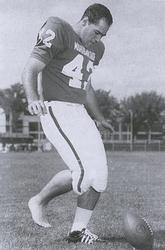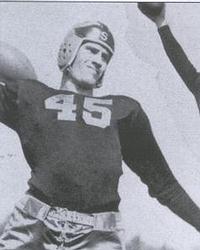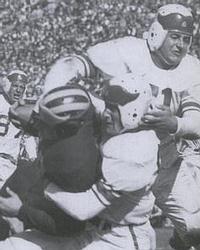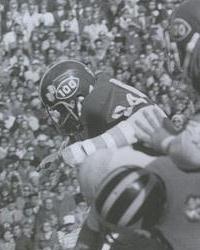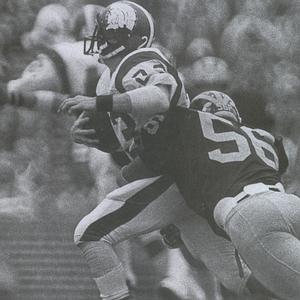It has been a long-standing tradition for many Michiganders to exit the
city and head "up north" to their rustic cabins for a week or two each summer.
There the entire family can enjoy the serenity of the surrounding lush green
vegetation and crystal clear lakes. Daytime activities such as hiking,
swimming and fishing are usually followed in the evening by campfire
conversations where the adults and children can openly share their memories
of past experiences in a most captivating environment.
This summer Helmet Hut was most pleased to receive a request from Michigan
State University to provide them with authentic reproductions of the various
helmet styles worn by their legendary Spartan football teams. This coming
fall the school will be celebrating the 40 year anniversary of their 1965
National Championship team. They are also making plans for next year to
celebrate the "Game of the Century," the fabled 1966 game with Notre Dame that
ended in a 10 - 10 tie. These helmets will be put on permanent display in the
museum portion of their impressive Duffy Daugherty Football Building. Prior to
delivering the helmets we felt it would be most appropriate to photograph them
in the same beautiful northern Michigan scenery that so many people enjoy each
summer. The rich Kelly green and white Spartan colors were simply stunning
when placed in this setting. Deep in Michigan's beautiful rural woods the
helmets turned almost lifelike, as if they were on their very own family
retreat. If helmets could talk, can you imagine the glorious recollections
that each generation represented could provide while sitting in front of one
of those crackling Michigan campfires?
Back in the early 1950s when Detroit was known as the world's leading
automobile manufacturer, Michigan State's East Lansing campus was often
referred to as the nation's "football factory." During the 1950s era the
Spartans churned out such impressive models as Lynn Chandnois, Dorne Dibble,
Don McAulliffe, Tom Yewcic, Sonny Granddelius, Earl Morrall and Dean Look.
Their 1951 undefeated and untied team claimed a share of the national
championship with Tennessee. The following year the team was again unbeaten
and untied. They ended the 1952 season with the nation's longest winning
streak (24 games) and were named the undisputed national champions by every
official poll. After being made to wait for several years the team was
finally admitted into the Big 10 as a regular member in 1953. They promptly
went on to capture the league championship (losing only one game during the
season) and beating UCLA in their first Rose Bowl game. After the 1953 season
Biggie Munn, the legendary Spartan coach, turned the team over to his protégé
and future legend Duffy Daugherty.
The 1960s "new model" introductions from the MSU's further
expanding "football factory" read like a "Who's Who" in both college and pro
football. Standout performers such as Fred Arbanas, Ed Budde, George Saimes,
Clinton Jones, Gene Washington, George Webster and Bubba Smith were included
in that vintage. Offensive lineman are often overlooked when recalling the
heroes of the past but check out an ESPN Classic replay of the famous 1966
game with the Irish and focus on the unbelievable pulling and trapping
offensive line play by MSU's Anthony Conti and Jerry West. They, along with
the rest of the Spartan offensive line, dominated one of Notre Dame's all time
greatest defensive units (led by All Americans Alan Page, Pete Duranko, Kevin
Hardy, Tom Schoen and Jim Lynch). MSU was the consensus national champion in
1965 and claimed a share of the 1966 national championship (as voted by the
National Football Foundation) with Notre Dame. Both the 1965 and 1966 MSU
teams are considered by many to be among the greatest in the history of
college football.
Duffy retired after the 1972 season. The Spartan teams of the 1970s did not
compare record wise with the storied teams of the 1950s and 1960s but the
"football factory" continued to produce outstanding talent. Brad Van Pelt, Joe
DeLamielleure, Billie Joe DuPree, Bill Simpson, Larry Bethea and Kirk Gibson
were some of the more notable players from that period. Among the decades more
memorable team performances was their 1974 upset (MSU had an unimpressive 3-3
record going into the game) of number one ranked Ohio State 16 - 13. The
outcome of the game was delayed for 45 minutes while
officials reviewed a potential game winning touchdown for OSU as time expired.
The officials, along with Big Ten commissioner Wayne Duke, ultimately ruled
that time had expired prior to the snap of the ball (To say OSU coach Woody
Hayes was not supportive of the final decision may be one of the decade's
greater understatements). In 1978 MSU defeated heavily favored Michigan 24-15
in hostile Ann Arbor. They went on to tie Michigan for the Big Ten title but
were not allowed to go the Rose Bowl because they were on NCAA probation.
As previously stated, several MSU football players went on to
play professional football after graduation from college. Perhaps more
interesting, is the lengthy list of former Spartan football players who never
played professional football but still managed to remain in the public eye.
James Caan played quarterback for the Spartan freshman team in 1956. You may
remember him better in the movies portraying Brian Piccolo in "Brian's Song
and Sonny Corleone in "The Godfather." Dean Look, the Spartans 1959 All
American quarterback served as an NFL on-field official for 29 years. He was
the side judge who signaled touchdown on the historical Joe Montana to Dwight
Clark pass better known as "The Catch." Steve Garvey #24 was a first string
defensive back for the 1967 Spartan team but is far more known for his
outstanding baseball career. Kirk Gibson was an All American wideout with
blazing speed at MSU in the late 1970s. However, Gibson is better remembered
for hitting historic World Series home runs for both the Detroit Tigers and
Los Angeles Dodgers. All American fullback Bob Apisa played on MSU's glory
teams of the mid 1960s. He joined the Screen Actors Guild in 1970 and has
subsequently appeared in more than 30 televisions shows and over 30 feature
films as an actor and stuntman. Dick Kenney, a Spartan kicker and teammate of
Apisa, never had pro football aspirations simply because of his unusual
kicking style which was not allowed in the NFL. The Hawaiian born Kenney
kicked the ball barefooted using a conventional (for that era) straight on
kicking style -- ouch! Ironically, Pent Gent, a very solid receiver for the
Dallas Cowboys during the mid 1960s (and author of the critically acclaimed
football novel and screenplay "North Dallas Forty") graduated from MSU but
never played college football. He was a starting forward for the Spartan
basketball team.
From the perspective of the helmet aficionado, the history of the Spartan
football helmet may be even more interesting than the legacy of the Spartan
teams and its players. In 1933 the Spartans hired Charlie Bachman from Notre
Dame as their new coach. Totally ignoring Michigan State's official green and
white school colors, Bachman outfitted the team in gold (from Notre Dame) and
black (neutral?) uniforms. Their leather helmets were predominately gold with
a contrasting black wing design at the front of the helmet. Centered inside
the wing silhouette was a gold colored block "S." It is somewhat ironic that
Michigan State's arch intrastate rival Michigan, who made the wing pattern
famous, did not start wearing the wing until 1938 or several years after
Michigan State first start wearing it. Michigan State continued to wear the
gold and black winged helmet until 1947 when Biggie Munn replaced Bachman on
the sidelines. Biggie immediately ordered newly designed green and white
uniforms which mirrored the official school colors. Their first game in 1947
was played on the road against Michigan. The Spartans entered the field at
Michigan Stadium wearing their new white leather helmets with a green wing
(similar to the Bachman black wing design only with a smaller white block
"S"). The Wolverines apparently did not think much of Michigan State's new
duds as they proceeded to trounce the Spartans 55-0! When Michigan State
returned to East Lansing to prepare for the following weeks home opener
against heavily favored Mississippi State the players soon discovered that
their almost new white leather helmets were suddenly retired by Coach Munn. As
Biggie distributed new Kelly green (with a white center stripe) plastic
suspension helmets to the downtrodden down team it was rumored that
his superstitious behavior was exceeded only by his authority to exceed the
team's uniform budget.
The Spartans responded with an unexpected 7-0 victory over Mississippi
State and the classy new helmet style has remained the virtual base design for
all subsequent MSU helmet design modifications. One noteworthy exception
occurred in 1954. The Spartans wore their traditional green helmets for their
season opener on the road in Iowa. For unknown reasons, new coach Duffy
Daugherty decided to unveil white helmets with a green center stripe the
following week for their home opener against Wisconsin. After losing to the
Badgers followed by a loss to Purdue, Duffy brought back the traditional green
helmets for good (perhaps someone finally told him what happened to Biggie
Munn after he initially introduced the white Spartan helmets in 1947). For the
1956 season Duffy added white 2" tall, NCAA (early 1960s Giants) style
numerals to the sides of the Spartan helmets. He switched to white 3"
tall, rounded (1960s SD Charger) style helmet numerals for the 1957 season and
retained that numeral style through the 1964 season. In 1965 Athletic Director
Burt Smith perhaps sensing that they were about to unleash a very special
football team conducted a contest among the student body to replace the helmet
numerals with a drawing of a Spartan head logo. The winning entry was approved
by Coach Daugherty and was adopted for use starting that year. With the new
logo came the anticipated on field success. Smaller white 2" tall, NCAA (early
1960s Giants) style numerals were relocated to the rear of the helmet,
flanking the center stripe. With the exception of a few minor alterations (the
general white border of the logo was changed to black and more closely tapered
to the contour of the Spartan head that it surrounded) this design was used
until Duffy retired after the 1972 season.
The Spartans, like many other college teams, substituted a NCAA
recommended logos design ("100" overlaid on a football shaped outline) in 1969
to commemorate the 100 year anniversary of college football. Denny Stolz, an
assistant to Duffy, was hired to replace him in 1973. Another student contest
was held to revitalize the look of the Spartan head logo. The winning design
resulted in a more abstract Spartan head that, although significantly larger,
was even harder to decipher within the sight-lines of the stadium compared to
the preceding design. This design was canned along with Coach Stolz after the
1975 season. The next coach, Darryl Rogers, was hired just prior to the start
of the 1976 season. The team quickly adopted his preference
for additional white one-half inch wide flanking stripes, both spaced one-half
inch from the traditional white one inch wide center stripe. Wide, white 3"
tall, full block (Raider) style numerals were positioned on the helmet sides
because a new logo design was not ready in time for the 1976 season. A green
colored facemask was also introduced. As the end of the suspension helmet era
quickly approached a new Spartan head design was implemented prior to the 1977
season. This predominately white colored logo had a more sharply contoured
silhouette style design that was significantly easier to recognize from
afar. It is also a style that is virtually identical to the logo that is used
for the current Spartan helmets.
We have only touched on the mere highlights that reflect the rich tradition
of Spartan football. Countless personalities from the past, colorful anecdotal
stories and endless tales of glory still remain. Those untapped recollections
are best left to those who are instinctively inspired by the Kelly green and
white. They are the Michigan State faithful who spend the best of their summer
leisure hours sharing these fond memories in the perfect environment -- near
the flickering flames, crackling sounds and unique aroma of a log burning
campfire located hundreds of miles north of their otherwise imperfect worlds.
If interested in any of these MSU helmets please
click on the photos below.


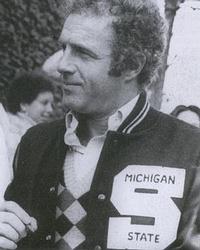
.jpg)
